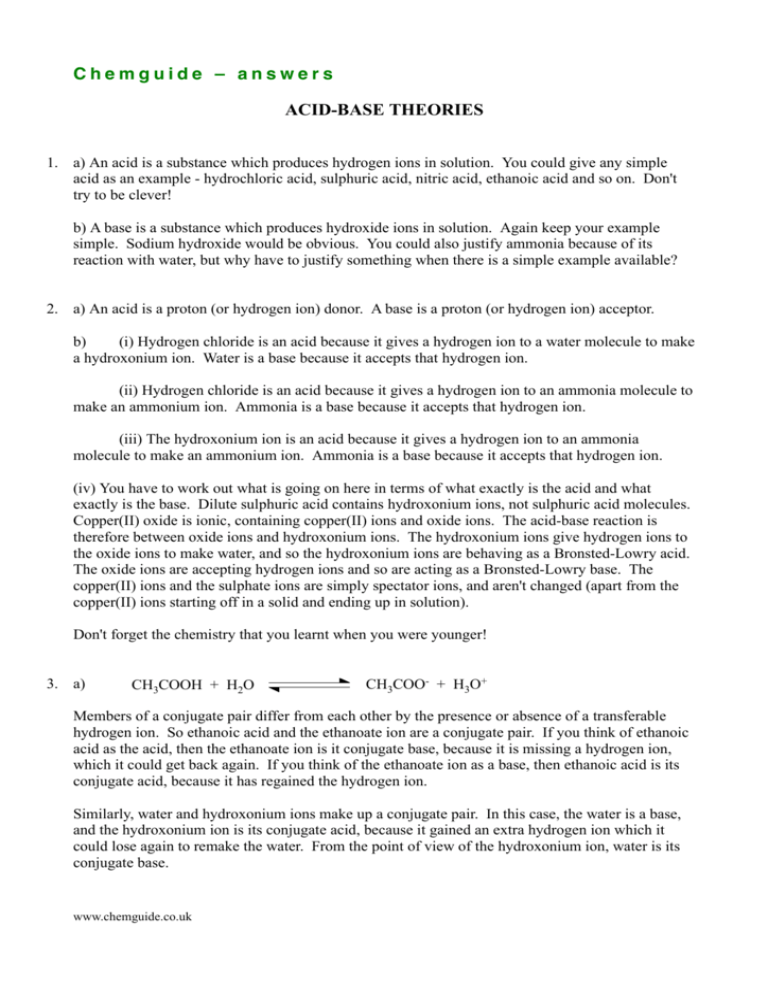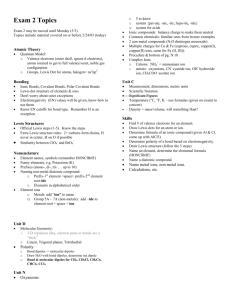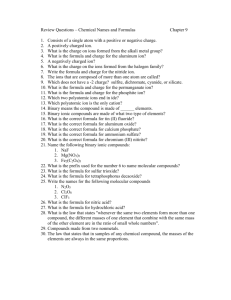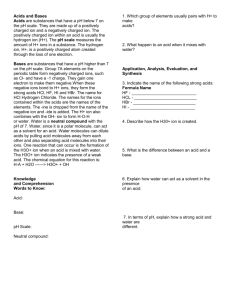Chemguide – answers ACID
advertisement

Chemguide – answers ACID-BASE THEORIES 1. a) An acid is a substance which produces hydrogen ions in solution. You could give any simple acid as an example - hydrochloric acid, sulphuric acid, nitric acid, ethanoic acid and so on. Don't try to be clever! b) A base is a substance which produces hydroxide ions in solution. Again keep your example simple. Sodium hydroxide would be obvious. You could also justify ammonia because of its reaction with water, but why have to justify something when there is a simple example available? 2. a) An acid is a proton (or hydrogen ion) donor. A base is a proton (or hydrogen ion) acceptor. b) (i) Hydrogen chloride is an acid because it gives a hydrogen ion to a water molecule to make a hydroxonium ion. Water is a base because it accepts that hydrogen ion. (ii) Hydrogen chloride is an acid because it gives a hydrogen ion to an ammonia molecule to make an ammonium ion. Ammonia is a base because it accepts that hydrogen ion. (iii) The hydroxonium ion is an acid because it gives a hydrogen ion to an ammonia molecule to make an ammonium ion. Ammonia is a base because it accepts that hydrogen ion. (iv) You have to work out what is going on here in terms of what exactly is the acid and what exactly is the base. Dilute sulphuric acid contains hydroxonium ions, not sulphuric acid molecules. Copper(II) oxide is ionic, containing copper(II) ions and oxide ions. The acid-base reaction is therefore between oxide ions and hydroxonium ions. The hydroxonium ions give hydrogen ions to the oxide ions to make water, and so the hydroxonium ions are behaving as a Bronsted-Lowry acid. The oxide ions are accepting hydrogen ions and so are acting as a Bronsted-Lowry base. The copper(II) ions and the sulphate ions are simply spectator ions, and aren't changed (apart from the copper(II) ions starting off in a solid and ending up in solution). Don't forget the chemistry that you learnt when you were younger! 3. a) CH3COOH + H2O CH3COO- + H3O+ Members of a conjugate pair differ from each other by the presence or absence of a transferable hydrogen ion. So ethanoic acid and the ethanoate ion are a conjugate pair. If you think of ethanoic acid as the acid, then the ethanoate ion is it conjugate base, because it is missing a hydrogen ion, which it could get back again. If you think of the ethanoate ion as a base, then ethanoic acid is its conjugate acid, because it has regained the hydrogen ion. Similarly, water and hydroxonium ions make up a conjugate pair. In this case, the water is a base, and the hydroxonium ion is its conjugate acid, because it gained an extra hydrogen ion which it could lose again to remake the water. From the point of view of the hydroxonium ion, water is its conjugate base. www.chemguide.co.uk Chemguide – answers b) CO32- + H2O HCO3- + OH- The conjugate pairs are the carbonate ion and hydrogencarbonate ion, and the water and hydroxide ion. The hydrogencarbonate ion is the conjugate acid of the carbonate ion; the carbonate ion is the conjugate base of the hydrogencarbonate ion. The water gives away a hydrogen ion and so is acting as an acid; the hydroxide ion is its conjugate base. As the hydroxide ion regains the hydrogen ion, it is acting as a base, and the water is its conjugate acid. 4. NH3 + H2O NH4+ + OH- HCl + H2O H3O+ + Cl- A substance is amphoteric if it can behave as both an acid and a base. In the first equation, water is acting as an acid, because it is giving a hydrogen ion to the ammonia. In the second equation, water is acting as a base, because it is accepting a hydrogen ion from the HCl. 5. a) A Lewis acid is an electron pair acceptor; a Lewis base is an electron pair donor. b) The aluminium atom has a space in its outer orbital which could accept a lone pair of electrons to make a dative covalent (coordinate covalent) bond. Aluminium chloride can certainly act as a Lewis acid. But there are also lone pairs of electrons on the chlorine atoms, which could possibly be used to form a bond with something else, so it could also be a Lewis base. If you have read the page on coordinate bonding, you will realise that both of these things happen when aluminium chloride forms Al2Cl6. www.chemguide.co.uk Chemguide – answers c) A magnesium ion, Mg2+, has the electron structure 2,8, with no electrons in its outer level. Water molecules combine with this by using their lone pairs to form coordinate covalent bonds with it, giving the ion, [Mg(H2O)6]2+. The magnesium ion is accepting electron pairs, and so is a Lewis acid. The water is donating electron pairs and so is a Lewis base. (In case you haven't come across this before and are interested, the magnesium uses a combination of its 3s, 3 x 3p and 2 x 3d orbitals in order to accept 6 lone pairs of electrons.) d) A Lewis base has a lone pair of electrons which it can use to form a bond to something else. NH3 has a lone pair of electrons on the nitrogen, and can act as a Lewis base. CH4 has no lone pairs, and so can't act as a Lewis base. F- has four lone pairs of electrons, and can act as a Lewis base. (If you are interested in an example, it forms complex ions like AlF63- in the same sort of way that the complex magnesium ion was formed in part (c).) OH- has lone pairs on the oxygen, and can act as a Lewis base. (That has to be the case, of course. You know that the OH- ion is a base in the Arrhenius and Bronsted-Lowry senses. So it has to be in the Lewis sense as well. As the theories get more complicated, they have to include all the examples from the earlier ones.) www.chemguide.co.uk








